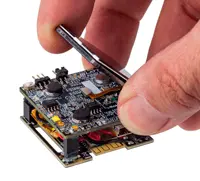Electronics News
Archive : 6 December 2015 год
 A development platform for use in designing low-power wearable devices has been launched by Lattice Semiconductor. Based on the iCE40 Ultra FPGA, the platform features a large number of sensors and peripherals.
A development platform for use in designing low-power wearable devices has been launched by Lattice Semiconductor. Based on the iCE40 Ultra FPGA, the platform features a large number of sensors and peripherals.
“One of the more popular applications to emerge from the growing Internet of Things market is wearable devices,” said product marketing manager Ying Chen. “However, with so many potential applications for wearables and their strict power requirements, it’s a challenge to find a semiconductor platform that features the right combination of low power operation and peripheral support.”
Hardware features and sensors supported by the iCE40 Ultra Wearable Development Platform include a 1.54in display, MEMS microphone, high brightness LED, IR LED, Bluetooth LE module and 32Mbyte of flash memory. The platform also supports sensors capable of measuring heart rate/SpO2, skin temperature and pressure, as well as an accelerometer and gyroscope.
The platform, which measures 1.5 x 1.57 x 0.87in, comes with a wrist strap and a built in battery.
Author
Graham Pitcher
Source: www.newelectronics.co.uk
 Renesas Electronics has unveiled the third generation of R-Car, an automotive SoC targeted at safety and in vehicle infotainment systems. The device, which features ARM Cortex-A57 and A53 cores, boasts a processing performance of 40,000 DMIPS. It also integrates Imagination Technologies’ PowerVR GX6650 GPU and the IMP-X5 parallel programmable engine for advanced image recognition technology.
Renesas Electronics has unveiled the third generation of R-Car, an automotive SoC targeted at safety and in vehicle infotainment systems. The device, which features ARM Cortex-A57 and A53 cores, boasts a processing performance of 40,000 DMIPS. It also integrates Imagination Technologies’ PowerVR GX6650 GPU and the IMP-X5 parallel programmable engine for advanced image recognition technology.
According to Renesas, R-Car H3 provides cognitive computing capabilities, the ability to process large volumes of information from vehicle sensors accurately in real-time, and support for applications that require complex processing, such as obstacle detection, driver status recognition, hazard prediction and hazard avoidance. The SoC also conforms to ISO 26262.
“The R-Car H3 SoC has the all round sensing, efficiency and safety characteristics that are essential in connected car technologies,” said James McNiven, general manager of ARM’s CPU group. “Alongside the inclusion of the ARM Cortex-R7 real time processor, the SoC also capitalises on the Cortex-A57 and Cortex-A53 cores in an ARM big.LITTLE configuration. This has allowed Renesas to deliver advanced vision and detection capabilities while controlling power and achieving the stability that safety critical electronics demand.”
Manufactured on a 16nm process, the device is sampling, but mass production is not planned until Q1 2018, with 100,000 units a month being manufactured in 2019.
Author
Graham Pitcher
Source: www.newelectronics.co.uk

